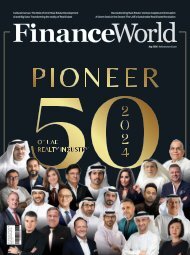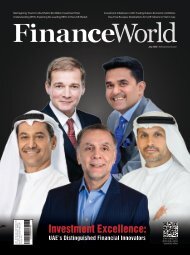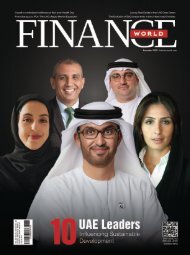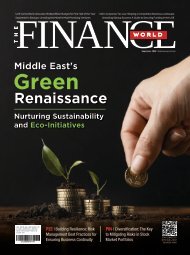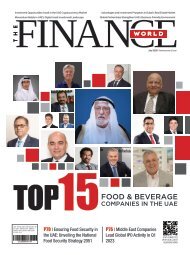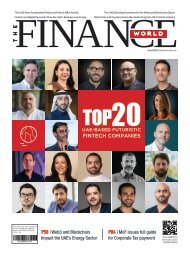The Finance World Magazine| Edition: March 2023
The March edition of The Finance World Magazine (TFW) delves into the Zayed Ambition 2 project, which strives to investigate the feasibility of leveraging the UAE's burgeoning space economy for sustainable development. This initiative showcases the country's commitment to diversifying its economy and reducing its reliance on oil. In a featured interview, CEO Shaaista Khan Osman and Managing Director Osman Osman of Blu Blood share their insights about the event management industry in the UAE. This issue also includes insights from Sridhar Vembu, CEO of Zoho Corporation, on emerging AI tools, along with some advice for SMEs and startups. Through this edition, we also bring you insights on topics like the UAE's steadfast dedication to sustainable growth and development, Dubai surpassing global and regional tourism recovery levels, the sports industry emerging as a promising sector magnetizing international investors, and many more key informational articles in the finance sector. Keep yourself up to date with all financial sector news with our current news segments. Each person can find something unique from us. We believe our readers deserve real value from what we have to offer.
The March edition of The Finance World Magazine (TFW) delves into the Zayed Ambition 2 project, which strives to investigate the feasibility of leveraging the UAE's burgeoning space economy for sustainable development. This initiative showcases the country's commitment to diversifying its economy and reducing its reliance on oil.
In a featured interview, CEO Shaaista Khan Osman and Managing Director Osman Osman of Blu Blood share their insights about the event management industry in the UAE. This issue also includes insights from Sridhar Vembu, CEO of Zoho Corporation, on emerging AI tools, along with some advice for SMEs and startups.
Through this edition, we also bring you insights on topics like the UAE's steadfast dedication to sustainable growth and development, Dubai surpassing global and regional tourism recovery levels, the sports industry emerging as a promising sector magnetizing international investors, and many more key informational articles in the finance sector.
Keep yourself up to date with all financial sector news with our current news segments. Each person can find something unique from us. We believe our readers deserve real value from what we have to offer.
Create successful ePaper yourself
Turn your PDF publications into a flip-book with our unique Google optimized e-Paper software.
when it was commissioned.<br />
From January 2020 through June<br />
2021, the Masterworks.io All Art Index<br />
achieved a 28.2% return – equivalent<br />
to broad, publicly-traded risk asset<br />
classes including developed market<br />
stocks, developing market equities,<br />
and commodities, as noted by a 2022<br />
Citibank Report.<br />
Hedge Against Inflation<br />
According to Masterworks internal<br />
research, during times of inflation<br />
equal to or more than 3.0% from 1985<br />
to 2020, Post-War & Contemporary art<br />
prices had an annual average actual<br />
price gain of 23.2%. According to Art<br />
Net, during periods of high inflation,<br />
art sales tend to grow, signalling a<br />
greater volume market and probable<br />
higher price appreciation.<br />
Aesthetic Value<br />
In comparison to other investment<br />
vehicles, art is a tangible asset that<br />
you may enjoy while keeping it in<br />
your portfolio. Because this is where<br />
the majority of the value of art is<br />
obtained, individuals who acquire it<br />
should value it.<br />
What Are the Risks of Investing<br />
in Art?<br />
When determining whether to invest<br />
in artwork, there are a few factors to<br />
consider, just like any other investment:<br />
• Illiquid & Long-Term Asset<br />
Investing in artwork is akin to<br />
investing in real estate or vintage<br />
vehicles in that they are very illiquid<br />
assets that cannot be quickly sold for<br />
cash. It is generally difficult to find<br />
a buyer for any collection, especially<br />
highly priced paintings. Finding a<br />
buyer on short notice might be very<br />
tough. <strong>The</strong>re are specific routes that<br />
must be followed in order to sell a<br />
work of art. Art investing should be<br />
part of a wider long-term investment<br />
plan and should not be anticipated<br />
to provide regular income or to be<br />
liquidated quickly.<br />
• Costs and Fees<br />
Investment worthy objects of art<br />
rarely come with a tiny price tag.<br />
<strong>The</strong>re are, of course, art investment<br />
funds and fractional shares of<br />
artwork that allow an investor to<br />
add art to their portfolio without<br />
spending a million dollars. If an<br />
investor wants to buy the art right<br />
away, they will need to spend<br />
some money on a desirable piece.<br />
Handling, storage, and insurance are<br />
all costs that may add up quickly.<br />
Art investors frequently aim on<br />
keeping onto artwork for a long<br />
time, in order to let it increase<br />
in value. Meanwhile, the investor<br />
would be required to pay for upkeep<br />
and repair.<br />
• Counterfeits and the Threat<br />
of Destruction<br />
<strong>The</strong> collections market is crowded<br />
with counterfeit objects, and it<br />
would be simple to fall victim unless<br />
an investor is highly informed<br />
in assessment. Before making<br />
any investment, it is critical to<br />
conduct research on what you are<br />
purchasing. <strong>The</strong>re are strategies<br />
to assist avoid becoming misled<br />
including: examine the certificate<br />
of authenticity; research the edition<br />
number; and examine the materials.<br />
Working with an expert or a third<br />
party, such as purchasing from an<br />
auction house or working with<br />
an appraiser, is another strategy<br />
to avoid falling for a counterfeit.<br />
Investing in art funds or fractional<br />
shares relieves the investor of the<br />
burden of authenticity.<br />
How to make your first investment<br />
in art?<br />
Art may be purchased simply from<br />
galleries and auction houses (both<br />
physical and online). You might also go to<br />
local art shows. Online publications and<br />
social media platforms like Instagram<br />
can assist you in discovering artists<br />
you like, and you can purchase works<br />
straight from the artists’ websites. You<br />
might also explore the realm of NFTs,<br />
which symbolise ownership of digital<br />
art. However, art investments may be<br />
made in a variety of methods, each<br />
with a different level of risk and profit.<br />
• High cost and high risk:<br />
Original artwork may be purchased<br />
at art fairs, galleries, and auctions,<br />
but doing so carries the highest price<br />
and risk. Try to purchase pieces<br />
from a budding artist in the hopes<br />
of discovering the next Banksy. A<br />
unique painting or sculpture may<br />
one day be worth considerably more<br />
than you bought for it, or you may<br />
find it difficult to sell it.<br />
• Low risk and low cost:<br />
Instead of purchasing an original,<br />
consider purchasing a reproduction<br />
of an original painting or sketch.<br />
Many artists and galleries will create<br />
limited-edition prints of their works<br />
and allow customers to purchase<br />
them at a specified retail price<br />
on their website. A high-quality,<br />
limited-edition print may be quite<br />
valuable and costs a fraction of<br />
the price of the original. However,<br />
because prints aren’t generally oneof-a-kind,<br />
they don’t appreciate as<br />
much as originals.<br />
• Low risk and high cost:<br />
You may acquire works by “bluechip”<br />
painters like Andy Warhol,<br />
which keep their value better but<br />
provide less financial appreciation<br />
or upside. Blue-chip painters are<br />
those whose works have the highest<br />
steady worth and are not subject<br />
to fads and speculation. Many firsttime<br />
investors cannot afford to<br />
purchase a high-end painting or<br />
sculpture, but numerous funds allow<br />
investors to purchase shares in a<br />
holding company that will purchase<br />
a high-end work of art.<br />
Additionally, if you are going to<br />
purchase particular works of art,<br />
you will most likely want to purchase<br />
works that make you joyful. If you<br />
invest $10,000 on an unattractive<br />
artwork because you expect its<br />
value to grow, you’re losing out on<br />
the fun element of investing in art<br />
vs other asset classes.<br />
In conclusion, investing in fine art<br />
may be a suitable fit for you if, you<br />
have a strong interest in art and<br />
are eager to learn more about it,<br />
or if you already have a portfolio<br />
of other investments and want to<br />
diversify your holdings. also, if<br />
you have an extremely high-risk<br />
tolerance, are willing to own a piece<br />
of art indefinitely, and can afford to<br />
maintain and insure the items you<br />
purchase, investment of art is the<br />
right investment for you.<br />
On the other hand, you should avoid<br />
investing in art if you anticipate<br />
returns that outperform the stock<br />
market, or if you have no intention of<br />
displaying the works you purchase.<br />
If you want to be able to rapidly<br />
and conveniently liquidate your<br />
assets, you should not invest in<br />
this area as well.<br />
<strong>March</strong> <strong>2023</strong> www.thefinanceworld.com 109




